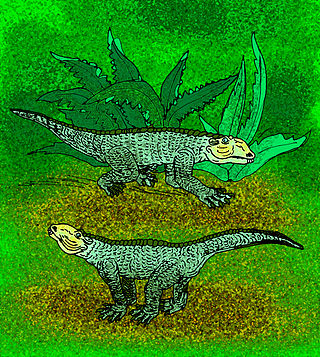
Chimaerasuchidae is a family of mesoeucrocodylians. It was erected as a clade in 2004 by Carvalho et al and included Chimaerasuchus from the Early Cretaceous of China and possibly also Simosuchus from the Late Cretaceous of Madagascar. The validity of the clade has been questioned in later studies that found the two genera to be more distantly related.

Mariliasuchus is an extinct genus of Late Cretaceous notosuchian mesoeucrocodylian found near Marilia, Brazil. The first bone remains were found and collected in 1995 by Brazilian paleontologist William Nava, in red rocks from the fossiliferous Adamantina Formation. Four years later, it was described as Mariliasuchus amarali, by Brazilian paleontologists Ismar de Souza Carvalho and Reinaldo J. Bertini.

Baurusuchus is an extinct genus of baurusuchid mesoeucrocodylian, which lived in Brazil from 90 to 83.5 million years ago, in the Late Cretaceous period. It was a terrestrial predator and scavenger, estimated to reach up to 113.4 kilograms (250 lb) in weight. Baurusuchus lived during the Turonian to Santonian stages of the Late Cretaceous Period, in Adamantina Formation, Brazil. It gets its name from the Brazilian Bauru Group. It was related to the earlier-named Cynodontosuchus rothi, which was smaller, with weaker dentition. The three species are B. pachechoi, named after Eng Joviano Pacheco, its discoverer, B. salgadoensis and B. albertoi. The latter species is disputed. Its relatives include the similarly sized Stratiotosuchus from the Adamantina Formation, and Pabweshi, from the Pakistani Pab Formation.

Peirosauridae is a Gondwanan family of mesoeucrocodylians that lived during the Cretaceous period. It was a clade of terrestrial crocodyliforms that evolved a rather dog-like skull, and were terrestrial carnivores. It was phylogenetically defined in 2004 as the most recent common ancestor of Peirosaurus and Lomasuchinae and all of its descendants. Lomasuchinae is a subfamily of peirosaurids that includes the genus Lomasuchus.

Baurusuchidae is a Gondwanan family of mesoeucrocodylians that lived during the Late Cretaceous. It is a group of terrestrial hypercarnivorous crocodilians from South America and possibly Pakistan. Baurusuchidae has been, in accordance with the PhyloCode, officially defined as the least inclusive clade containing Cynodontosuchus rothi, Pissarrachampsa sera, and Baurusuchus pachecoi. Baurusuchids have been placed in the suborder Baurusuchia, and two subfamilies have been proposed: Baurusuchinae and Pissarrachampsinae.

Sphagesaurus is an extinct genus of sphagesaurid notosuchian crocodylomorph from the Late Cretaceous of southwest São Paulo, southern Brazil.
The Adamantina Formation is a geological formation in the Bauru Basin of western São Paulo state, in southeastern Brazil.

Armadillosuchus is an extinct genus of sphagesaurid crocodylomorph. It was described in February 2009 from the late Campanian to early Maastrichtian Adamantina Formation of the Bauru Basin in Brazil, dating to approximately 70 Ma. Armadillosuchus was among the larger and more robust sphagesaurids, with a total length of approximately 2 metres (6.6 ft).

Morrinhosuchus is an extinct genus of notosuchian crocodyliform from the Late Cretaceous Adamantina Formation of Brazil. It is known from a mandible and a portion of the front of the skull collected from the municipality of Monte Alto in São Paulo state. Morrinhosuchus refers to Morrinho de Santa Luzia, a hill nearby the collection site of the holotype, while luziae refers to the chapel of Santa Luzia, which is located on top of the hill.
Candidodontidae is a family of notosuchian crocodyliforms. It was originally used in 2002 as a name for a clade that includes the genera Araripesuchus, Candidodon, and Malawisuchus. Later in 2004 the family was formally defined as a node-based taxon including Candidodon itapecuruense and Mariliasuchus amarali. A 2009 study redefined Candidodontidae as a stem-based taxon which included Candidodon, Malawisuchus, and possibly Mariliasuchus.

Stratiotosuchus is an extinct genus of baurusuchid mesoeucrocodylian from the Adamantina Formation in Brazil. It lived during the Late Cretaceous. The first fossils were found in the 1980s, and the type species Stratiotosuchus maxhechti was named in 2001. A hyperpredator, it and other baurusuchids may have filled niches occupied elsewhere by theropod dinosaurs.
Pepesuchus is an extinct genus of carnivorous metasuchian from the Late Cretaceous period. It is a peirosaurid which lived during the Campanian and Maastrichtian stages of the Late Cretaceous in what is now state of São Paulo, Brazil. It was a semiaquatic crocodylomorph.

Campinasuchus is an extinct genus of baurusuchid mesoeucrocodylian from Minas Gerais State of Brazil.
Caryonosuchus is an extinct genus of sphagesaurid notosuchian known from the Late Cretaceous of São Paulo State, southeastern Brazil.
Labidiosuchus is an extinct genus of notosuchian mesoeucrocodylian from Minas Gerais State, southeastern Brazil. Labidiosuchus had a very bizarre dentition and its lower jaw had a Y-shaped outline.

Barreirosuchus is an extinct genus of trematochampsid notosuchian known from the Late Cretaceous of São Paulo State, southeastern Brazil. It contains a single species, Barreirosuchus franciscoi. It is most closely resembles Caririsuchus camposi from the Araripe Basin and Itasuchus jesuinoi also from the Bauru Basin, and shares with them several synapomorphies.

Aplestosuchus is an extinct genus of baurusuchid mesoeucrocodylian known from the Late Cretaceous Adamantina Formation of São Paulo, southern Brazil. It contains a single species, Aplestosuchus sordidus. A. sordidus is represented by a single articulated and nearly complete skeleton, preserving the remains of an unidentified sphagesaurid crocodyliform in its abdominal cavity. The specimen represents direct evidence of predation between different taxa of crocodyliforms in the fossil record.

Thanos is a genus of carnivorous brachyrostran abelisaurid dinosaur that lived in Brazil during the Santonian stage of the late Cretaceous Period. It contains only a single species known as T. simonattoi.
Aphaurosuchus is an extinct genus of baurusuchid mesoeucrocodylian known from the Late Cretaceous Bauru Basin of São Paulo, southern Brazil. It contains two species, Aphaurosuchus escharafacies and Aphaurosuchus kaiju.
Ibirania is a genus of dwarf saltasaurine titanosaur dinosaur from the Late Cretaceous São José do Rio Preto Formation of Southeast Brazil. The type species is Ibirania parva. It is one of the smallest sauropods known to date, comparable in size to the titanosaur Magyarosaurus.















